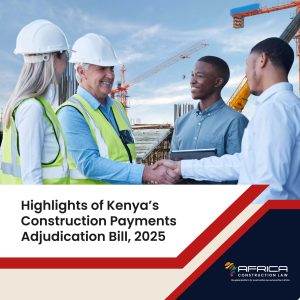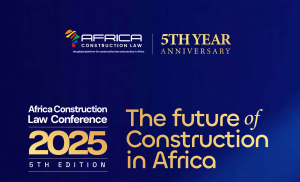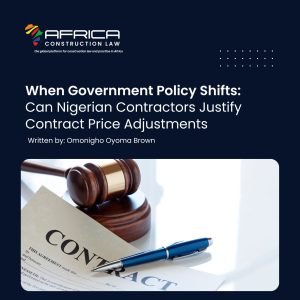Rising Risk of Disputes in Construction Projects in Kenya in the Aftermath of the Pandemic
by Eng. Wahome G. Wambugu,* Projects Director, Ongata Works Ltd
In response to the Covid-19 pandemic, the Kenyan government implemented various measures under the Public Health Act, to curb the spread of the virus. These measures included: curfews or shelter-in place directives lasting up to 10 hours per day; directives for all vehicles to carry less than half their capacity of passengers to encourage social distancing; a work-from-home advice for all non-essential workers (construction personnel were considered non-essential workers); and a restriction on air travel leading to closure of most hotels and other accommodation across the country, further restricting the free movement of workers.
Predictably, construction projects in Kenya faced various impediments because of these measures, and have been exposed to other risks which have a significant impact on the cost and the time that it takes to complete. This article will endeavor to explain the sources of these risks, and how they can be mitigated to avoid disputes.
Risks to different parties to the construction contract
The Employer and the Engineer
It is the responsibility of the Engineer in a FIDIC contract to provide complete designs and scope for construction. However, the above social distancing measures designed to prevent the spread of the Covid-19 virus under the Public Health Act, which hinder the Engineers’ and designers’ ability to conduct meetings, interrogations and site visits, have disrupted the smooth running of design, procurement and supervision of construction contracts by the Engineer, particularly in Civil Works.
Employers tend to discourage even the Contractor’s pre-tender site visits. This leads to procurement that is inaccurate in scope and quantities and, inevitably, variations by the Engineer’s team during the construction period, thereby raising contract prices above levels permissible by the Employer. Meanwhile, the Employer faces stricter budgets caused by reduced earnings during the onslaught of the Covid-19 Pandemic, and therefore, has less room to increase contract prices.
The Contractor
The pandemic and Public Health Act measures have left the Contractor and their Suppliers less able to promptly respond to variations and additional works. Haulage risks for materials, credit risk from suppliers and cash flow risk from financiers, contribute to this difficulty.
During the pandemic, suppliers for construction products have reduced in number, are less stable and are offering shorter credit periods. Introducing new materials or increasing the quantity of materials in a construction project has the effect of increasing the time and cost of acquiring materials. The restricted working hours within which haulage of materials can take place, and the risk of spreading infection amongst transit workers, compounds the problem. Additionally, the Contractor’s cash flow is impeded by delayed payment due to delayed production of works as variations are implemented, and difficulties in obtaining financing from banks during the credit crunch caused by the pandemic.
Why Disputes Arise
Variations and additional works have always been part of FIDIC construction contracts and are nothing new. What has changed is the pandemic, and resultant Public Health Act measures which impact parties’ ability to avoid, or process, finance and implement these variations and additional works, and be suitably compensated for the increase in time and cost.
Therefore, disputes can, and are expected to, arise on various issues such as disruption of works program (prolongation), breach of permissible limits of the contract price and quantities, delay of works design details and supplies for the same, delayed payments by the employer, and abandonment of works by the contractor due to lack of cash flow.
A practical example is the Relocation of Existing Services from the construction corridor which includes electricity poles, water and waste water lines. As discussed, this type of item is now more often overlooked at design stage by the Engineer and is therefore not scoped and/or budgeted for by the Employer.
The risk of disputes regarding disruption have increased due to (i) fewer inter-party working meetings taking place at which issues may be amicably resolved, (ii) less room for the Engineer to incorporate the additional works to the project budget, (iii) inability of the “working-from-home” utilities providers to respond in a timely fashion, and the lack of ready supplies for these additional works (e.g., where imported steel pipes are required for relocating water lines).
After much back and forth in contractual correspondence without resolution due to the above impediments, the reduced production followed by lack of ability to raise adequate payment certificates and thereby garner cash flow, leaves the Contractor with little option but to abandon the site and raise a claim due to the project site not being free of encumbrances, and thereafter a prolongation of program claim where costs of idle plant, labour and resources are claimed by the Contractor. The Employer, on the other hand, might terminate the contract for convenience or, worse still, terminate the Contractor for abandonment of site. All these issues pave the way for a contractual dispute.
Avoiding such disputes
It is critical that design review and financial appraisals for the revised scope are prioritized at the commencement of the project. Under normal circumstances, design reviews would be conducted on a need basis throughout the project, and financial appraisals finalized at the tail end of the project to cater for design reviews up to the conclusion of the project. However, it is imperative, in these times, that design reviews are frozen within the industry standard of 28 days programmed for resource mobilization and set out the construction, at the commencement of the project. This is to allow, where applicable, financial appraisals to be completed for the Employer’s budgeting. Budgeting and allocation may take time. For example, in a national project, the Employer would need to apply to the national treasury for additional funds, and this is usually done annually, with a supplementary budget midway through the financial year.
Another way to avoid disputes is to protect the Contractor’s cash flow. This can be done in several ways: Employers could ensure regular payment to the Contractor for works done; make advance payment to the Contractor – a measure which is gaining popularity; and project teams have had great success with requesting the Employer to pay for materials directly to suppliers to enable early production and delivery for items like pre-cast concrete.
The Engineer should also promote more face-to-face meetings between the parties to discuss reduction of risks to the project, with Covid-related restrictions in place. Such meetings reduce the risk of the exchange of adversarial contractual correspondence, which diminishes the goodwill of the stakeholders in a project.
If, despite the parties’ best efforts, a dispute ultimately arises, these can be referred to the Dispute Adjudication Board (DAB), which is provided for in FIDIC contracts after the 1999 edition, and is the key to resolving disputes in a timely and cost-effective manner. The DAB usually comprises of one or three persons (normally three for larger projects) with educational background in the built environment, for example Engineers, and with a background in Alternative Dispute Resolution procedures (i.e., an educational history in law and/or membership of the Chartered Institute of Arbitration). The DAB is nominated by the parties to the works by the end of the mobilization period, that is, 28 days from commencement of works order, and is on hand only when called upon, to adjudicate technical and commercial issues arising between the parties in the contract.
However, though provided for in FIDIC standard contracts as one of the first lines of dispute avoidance, the setting up of a DAB has not been common in the Kenyan construction sector due to a perceived duplication of the role of the Engineer. However, in the wake of the pandemic, it is now crucial, especially in cases where the Engineer is at the center of the disputed issue. This is because the DAB essentially facilitates a more formal mechanism to resolve the dispute.
Whilst decisions of the DAB are not binding, and parties can still pursue arbitration and thereafter lodge a case at the High Court of Kenya, the DAB is nevertheless a technical and objective dispute mechanism to resolve matters. Decisions from the DAB can be persuasive in arbitrations.
*Wahome G. Wambugu has over 10 years’ experience in FIDIC construction contract administration. Eng. Wahome holds a Bachelors of Civil Engineering, and has a passion for construction dispute avoidance and mitigation tools. He is a holder of a post-graduate diploma in Strategic Project Management. Thereafter qualifying as an associate member of the CIArb, Wahome has attended and been part of dispute resolution mechanisms (mediation, negotiation adjudication, arbitration) in various construction contracts in Kenya. Currently, he is the Projects Director at Ongata Works Ltd, an NCA 1 Building and Civil Engineering Contractor.


















